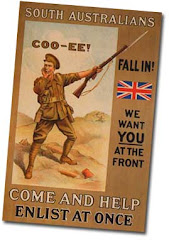
Douglas Evans was a son of David Evans of Upper Sturt. As a boy he attended Sunday school at the Methodist Church at Iron Bank. Before the war he worked as a gardener and lived in Upper Sturt.
He enlisted on 3 April 1916 at the age of 29, and after a period of training in England joined the 48rd Battalion in France in December 1916. During early months of 1917 the battalion rotated in and out of the trenches near Gueudecourt. During 1917, the 48th Battalion fought in the disastrous First Battle of Bullecourt in France in April where the battalion's casualties totalled 14 officers and 421 other ranks. After being thrown in by companies to support the brigade attack at Messines in June, the battalion received reinforcements, and had some rest behind the lines. The battalion's next major action was the First Battle of Passchendaele in Belgium in October, where over half the battalion became casualties. In late October Douglas spent two weeks on leave in England then a stint at the ANZAC Corps training school. After rotating in and out of the trenches during the winter of 1917/1918 with the battalion, Douglas was promoted to Lance Corporal in February 1918. This promotion marked the beginning of a remarkable six months for Douglas.
The 48th Battalion played a crucial part in stopping the German Spring offensive in front of Amiens in late March and early April 1918, and following the attack on Monument Wood in early May, Douglas was promoted to Corporal. The battalion took part in the Battle of Amiens in August 1918, and following that battle Douglas was again promoted, this time to Sergeant, as the battalion helped drive the Germans back to the Hindenburg Line. Douglas was now the Scout Sergeant of the 48th Battalion, responsible for reconnaissance, patrolling and laying of 'jumping off' tapes for attacks. During a spell in mid September 1918, his commanding officer recommended him for a mention in dispatches for his performance as Scout Sergeant, describing him as a brilliant patrol leader who displayed daring and skill especially during night patrols.
He enlisted on 3 April 1916 at the age of 29, and after a period of training in England joined the 48rd Battalion in France in December 1916. During early months of 1917 the battalion rotated in and out of the trenches near Gueudecourt. During 1917, the 48th Battalion fought in the disastrous First Battle of Bullecourt in France in April where the battalion's casualties totalled 14 officers and 421 other ranks. After being thrown in by companies to support the brigade attack at Messines in June, the battalion received reinforcements, and had some rest behind the lines. The battalion's next major action was the First Battle of Passchendaele in Belgium in October, where over half the battalion became casualties. In late October Douglas spent two weeks on leave in England then a stint at the ANZAC Corps training school. After rotating in and out of the trenches during the winter of 1917/1918 with the battalion, Douglas was promoted to Lance Corporal in February 1918. This promotion marked the beginning of a remarkable six months for Douglas.
The 48th Battalion played a crucial part in stopping the German Spring offensive in front of Amiens in late March and early April 1918, and following the attack on Monument Wood in early May, Douglas was promoted to Corporal. The battalion took part in the Battle of Amiens in August 1918, and following that battle Douglas was again promoted, this time to Sergeant, as the battalion helped drive the Germans back to the Hindenburg Line. Douglas was now the Scout Sergeant of the 48th Battalion, responsible for reconnaissance, patrolling and laying of 'jumping off' tapes for attacks. During a spell in mid September 1918, his commanding officer recommended him for a mention in dispatches for his performance as Scout Sergeant, describing him as a brilliant patrol leader who displayed daring and skill especially during night patrols.
Eleven days later the battalion was in the first wave of attacks on the outposts of the Hindenberg Line opposite Bellenglise, after which his commanding officer wrote that he had displayed conspicuous gallantry and devotion to duty, untiring energy and disregard for personal safety, which inspired all men working with him. He was subsequently awarded both the Military Medal and the Belgian Croix-de-Guerre for his actions during the period from February to September 1918. He was granted leave in England in early November 1918, but returned to the battalion in France until he started his return voyage to Australia in April 1919. He arrived back in Adelaide in August, and was discharged in September 1919.
He returned to Upper Sturt after the war, and during the Second World War was living in Crafers when he enlisted as a Sergeant in the 4th Battalion of the Volunteer Defence Corps, in which he served until October 1945.
He returned to Upper Sturt after the war, and during the Second World War was living in Crafers when he enlisted as a Sergeant in the 4th Battalion of the Volunteer Defence Corps, in which he served until October 1945.







No comments:
Post a Comment